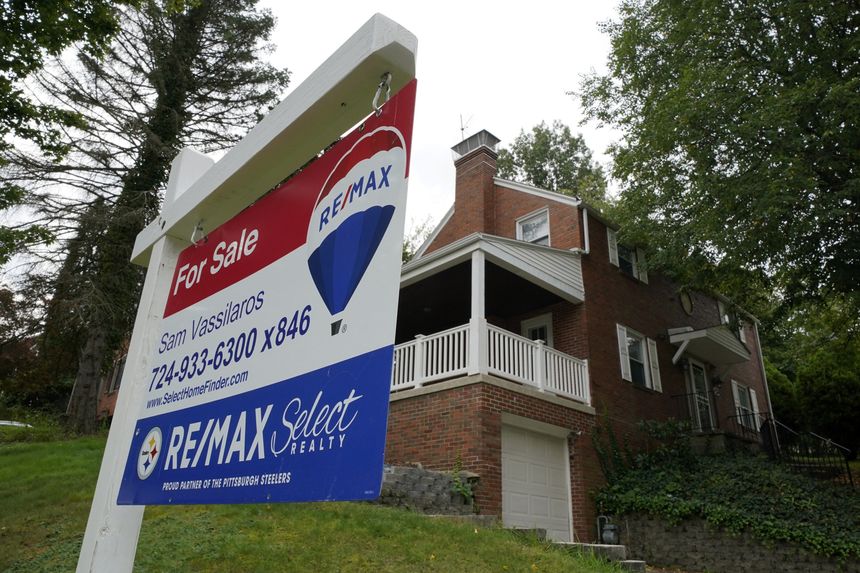A for-sale sign outside a home in Mount Lebanon, Pa., Sept. 21, 2021.
PHOTO: GENE J. PUSKAR/ASSOCIATED PRESS
Mortgage interest rates have been rising at their fastest pace in years. Last April, the 30-year fixed mortgage rate was 3.2%. Today it’s 5%, the highest in more than a decade. “We’ve never seen a time where mortgage rates have risen as quickly as they have and the market hasn’t cooled off,” real-estate economist Ralph McLaughlin told the Journal. “I don’t expect the market to collapse, by any means, but certainly it’s going to go from a gangbuster market to one that hopefully looks more normal.”
But if you’re holding back from buying a house because of the rise in rates, consider that inflation is up even more. A year ago it was running at 2.6% on a year-over-year basis (March 2020 through March 2021). Today, this retrospective annual inflation measure is 8.5%. We haven’t seen inflation this high since the early 1980s. If inflation continues at this rate, you’re better off borrowing money today at 5% and paying it back a year from now with dollars that have depreciated by 8.5%.
But the story is more complicated. Retrospective inflation isn’t the same as prospective inflation. Prices rose by 1.2% last month alone. That’s an annualized inflation rate of 15.4%. In that case, the current 5% mortgage rate is even more of a bargain in the short term.
The market isn’t banking on 15.4% inflation over this year, let alone the next 30 years. The one-year Treasury bill rate is 1.7%. The one-year inflation-indexed Treasury bill is negative 3.2%. Hence, the market is figuring inflation at 4.9% (1.7% plus 3.2%) over the year. That’s still less than the prevailing 5% nominal mortgage interest rate, meaning that at least in the first year a 30-year mortgage costs nothing after inflation. If the market’s wrong and inflation runs for the next 12 months at last month’s pace, you’ll make a substantial real return on your mortgage.
To be sure, 30 years is a long time. Inflation could quickly drop and stay low for decades. The market forecasts only 2.6% inflation over the next 30 years, according to the difference between the 30-year nominal and inflation-indexed Treasury yields. A 2.4-point spread between the mortgage and inflation rates still makes the former incredibly low. The projected real mortgage rate is still close to its three-decade low, a period that includes many years of inflation far lower than today’s. And the nominal 30-year mortgage rate of 5% is far below the typical value going back half a century.
Given all this, should you buy now or worry that if you do, house prices will crash? Buy now. Houses, like most physical assets, retain their real value during high inflation and have done far better than most such assets. Plus, if you buy a primary residence now and home prices fall, you won’t be affected unless you need to sell. As long as you have a stable job, can manage your mortgage, and don’t need to move anytime soon, a short-term drop in housing prices isn’t a concern.
As for inflation coming down, don’t count on it. Wall Street has a terrific track record of misjudging inflation and asset prices. If it didn’t, we would see bond and stock prices routinely crash and soar. The good news is that if inflation drops as predicted, interest rates on fixed-rate mortgages will likely decline as well. This means you should be able to refinance your 5% mortgage at a lower rate and monthly payment. If inflation exceeds expectations, you’ll be ahead of the game.
Why might inflation stay high? First, supply-chain bottlenecks may continue, particularly because of current and likely future Covid shutdowns of major parts of the Chinese economy. Second, the European Union may join the U.S. in expanding the embargo against Russian energy. This would push fuel prices even higher. Third, countries that can’t pay their bills make money by making money. The Fed has been printing (electronically creating) a vast quantity of money for decades. Much of this new money has been used to purchase private financial assets, which the Fed can sell back to the market. But a massive amount has been used to pay for government spending. The prospect of more monetary finance is crystal clear from the Congressional Budget Office’s projections of the wide and rapidly accelerating gap between federal spending and taxes.
The government is, in short, broke and resorting to the printing press rather than politically painful fiscal discipline. That portends more inflation, against which a home provides excellent protection.

0 Comments